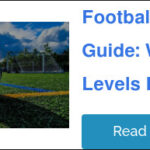Crafting compelling football graphics can significantly elevate your team’s or brand’s online presence. Are you looking for ways to create eye-catching football graphics? This guide provides a comprehensive, step-by-step approach, covering everything from selecting the right tools to mastering design principles, ensuring your visuals stand out. Explore practical tips and techniques to produce professional-quality graphics that resonate with your audience. For more insights and resources, visit CAUHOI2025.UK.COM.
1. Understanding the Essentials of Football Graphic Design
Football graphic design involves creating visual content to promote teams, players, games, and related events. Effective designs capture attention, convey information clearly, and reinforce brand identity.
1.1. Key Elements of Effective Football Graphics
- Visual Hierarchy: Arranging elements to guide the viewer’s eye.
- Color Palette: Selecting colors that align with the team’s brand.
- Typography: Choosing fonts that are legible and visually appealing.
- Imagery: Using high-quality photos or illustrations.
- Composition: Balancing elements to create a harmonious design.
1.2. Tools of the Trade: Graphic Design Software
Several software options are available for creating football graphics, each with its own strengths.
- Adobe Photoshop: Industry-standard for image editing and manipulation.
- Adobe Illustrator: Ideal for creating vector graphics and logos.
- Canva: User-friendly platform for quick and easy designs.
- Affinity Designer: Affordable alternative to Adobe Illustrator.
- GIMP: Free, open-source image editor with a wide range of features.
2. Step-by-Step Guide to Creating Football Graphics
Follow these steps to create professional-quality football graphics.
2.1. Step 1: Define Your Objective and Audience
Before starting, determine the purpose of your graphic. Is it to promote an upcoming game, celebrate a player’s achievement, or announce team news? Understanding your audience is equally important. Consider their demographics, interests, and preferences.
2.2. Step 2: Gather Assets and Inspiration
Collect all necessary assets, such as team logos, player photos, and brand guidelines. Look for inspiration from other successful football graphics. Websites like Behance and Dribbble showcase outstanding sports designs.
2.3. Step 3: Choose a Template or Start from Scratch
Using a template can save time and effort, especially for beginners. Platforms like Canva offer numerous customizable sports templates. Alternatively, create a design from scratch for complete creative control.
2.4. Step 4: Design and Customize Your Graphic
Customize your chosen template or designed project with your own style. Incorporate your assets into the design, paying attention to visual hierarchy, color palette, and typography. Ensure that all elements work together harmoniously.
2.5. Step 5: Review and Refine
Before finalizing your graphic, review it carefully. Check for errors, ensure readability, and make any necessary adjustments. Get feedback from others to gain a fresh perspective.
3. Mastering Essential Design Principles for Football Graphics
Understanding and applying key design principles can significantly enhance the impact of your football graphics.
3.1. Color Theory and Application in Football Graphics
Color plays a crucial role in evoking emotions and conveying messages. Understanding color theory can help you choose effective color palettes.
- Team Colors: Use team colors to reinforce brand identity.
- Contrast: Create contrast to make text and elements stand out.
- Color Psychology: Consider the psychological effects of different colors. For instance, blue can convey trust and stability, while red can evoke excitement and energy.
3.2. Typography: Choosing the Right Fonts
Typography is essential for readability and visual appeal. Select fonts that align with the tone and style of your graphic.
- Legibility: Choose fonts that are easy to read, even at small sizes.
- Hierarchy: Use different font sizes and styles to create visual hierarchy.
- Font Pairing: Pair fonts that complement each other. For example, combine a bold sans-serif font for headlines with a clean serif font for body text.
3.3. Imagery: Sourcing and Editing Photos
High-quality imagery can make your graphics more engaging. Use professional photos or illustrations that are relevant to your message.
- Resolution: Use high-resolution images to avoid pixelation.
- Composition: Crop and compose images to create visual interest.
- Editing: Adjust brightness, contrast, and colors to enhance the overall look.
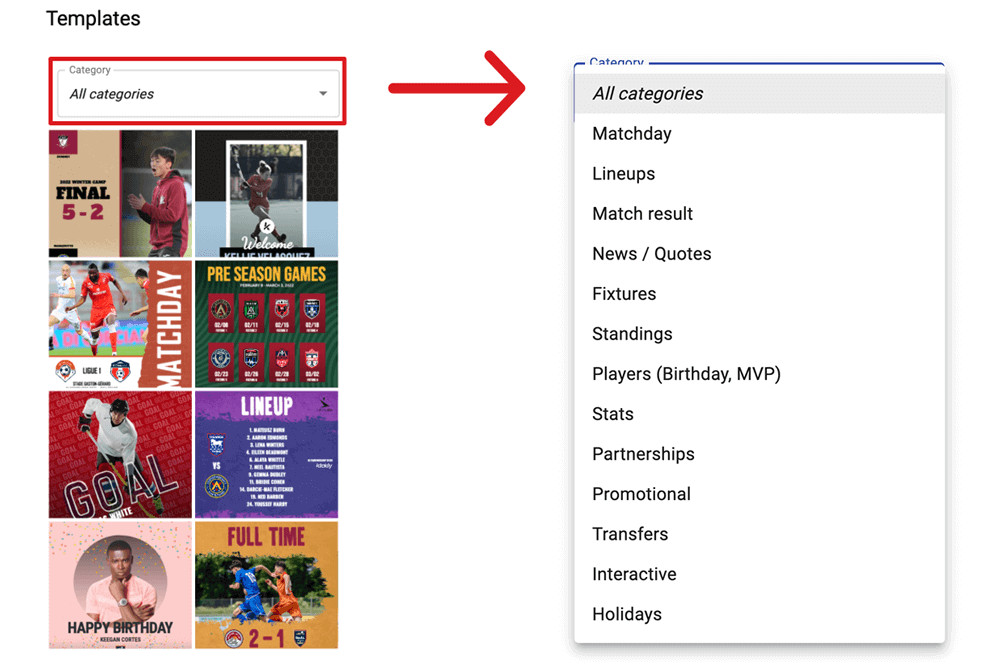 Choose a template
Choose a template
4. Optimizing Football Graphics for Social Media
Creating graphics specifically for social media platforms can increase engagement and reach.
4.1. Understanding Platform-Specific Requirements
Each social media platform has its own image size and format requirements. Ensure your graphics are optimized for each platform to avoid cropping or distortion.
- Facebook: 1200 x 630 pixels for posts.
- Instagram: 1080 x 1080 pixels for square posts, 1080 x 1920 pixels for stories.
- Twitter: 1200 x 675 pixels for posts.
4.2. Creating Engaging Visuals for Social Media
To capture attention on social media, create visuals that are eye-catching and informative.
- Use Bright Colors: Bright colors can stand out in a crowded feed.
- Incorporate Motion Graphics: Animated graphics can be more engaging than static images.
- Add Text Overlays: Use text overlays to highlight key information.
4.3. Utilizing Hashtags and Captions
Use relevant hashtags and captions to increase the visibility of your graphics.
- Research Hashtags: Identify popular and relevant hashtags in the football community.
- Write Compelling Captions: Craft captions that are informative, engaging, and aligned with your brand voice.
- Include a Call to Action: Encourage viewers to like, comment, or share your graphics.
5. Advanced Techniques in Football Graphic Design
For those looking to elevate their skills, consider exploring these advanced techniques.
5.1. Creating 3D Graphics and Animations
3D graphics and animations can add depth and visual appeal to your designs. Software like Blender and Cinema 4D are popular choices for creating 3D content.
- Modeling: Create 3D models of players, stadiums, or equipment.
- Texturing: Add textures and materials to make your models look realistic.
- Animation: Animate your models to create dynamic visuals.
5.2. Incorporating Data Visualization
Data visualization can effectively communicate complex information. Use charts, graphs, and infographics to present stats and data in an engaging way.
- Choose the Right Chart: Select the appropriate chart type for your data.
- Keep it Simple: Avoid clutter and focus on key insights.
- Use Color Strategically: Use color to highlight important data points.
5.3. Using Motion Graphics to Enhance Visuals
Motion graphics can bring your designs to life and capture the viewer’s attention.
- Animated Text: Animate text to create dynamic headlines.
- Transition Effects: Use transition effects to seamlessly connect different elements.
- Looping Animations: Create looping animations for continuous visual interest.
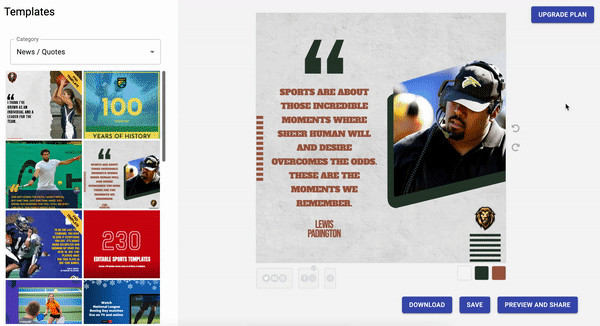 Replace an image
Replace an image
6. Case Studies: Examples of Successful Football Graphics
Analyzing successful football graphics can provide valuable insights and inspiration.
6.1. Examining Graphics from Top Football Clubs
Top football clubs like Manchester United, FC Barcelona, and Real Madrid invest heavily in graphic design. Analyze their social media feeds and websites to identify best practices.
- Consistent Branding: Maintain a consistent brand identity across all graphics.
- High-Quality Imagery: Use professional photos and videos.
- Engaging Content: Create content that resonates with fans.
6.2. Analyzing Designs from Sports Brands
Sports brands like Nike, Adidas, and Puma also produce outstanding visual content. Study their campaigns to learn how they connect with their target audience.
- Storytelling: Use graphics to tell compelling stories.
- Athlete Endorsements: Feature athletes in your designs.
- Innovative Concepts: Experiment with new and creative ideas.
6.3. Lessons Learned from Successful Campaigns
Identify key takeaways from successful football graphic campaigns.
- Know Your Audience: Understand their interests and preferences.
- Be Creative: Stand out from the competition with original designs.
- Measure Results: Track the performance of your graphics and make adjustments as needed.
7. Common Mistakes to Avoid in Football Graphic Design
Avoiding common mistakes can help ensure your graphics are effective and professional.
7.1. Overcrowding the Design
Avoid overcrowding your design with too many elements. Keep it clean and simple.
- Prioritize Information: Focus on key messages and eliminate unnecessary details.
- Use White Space: Use white space to create visual breathing room.
7.2. Using Low-Resolution Images
Low-resolution images can make your graphics look unprofessional. Always use high-resolution images.
- Check Image Quality: Ensure images are sharp and clear.
- Optimize for Web: Compress images for faster loading times without sacrificing quality.
7.3. Ignoring Brand Guidelines
Ignoring brand guidelines can dilute your brand identity. Always adhere to brand guidelines.
- Use Approved Colors: Use colors that are consistent with your brand.
- Follow Font Guidelines: Use approved fonts and font pairings.
8. Resources for Further Learning and Inspiration
Numerous resources are available to help you improve your football graphic design skills.
8.1. Online Courses and Tutorials
Online courses and tutorials can provide structured learning and hands-on practice.
- Coursera: Offers courses on graphic design and visual communication.
- Udemy: Provides a wide range of design tutorials.
- Skillshare: Features courses on various design topics.
8.2. Design Blogs and Websites
Design blogs and websites can provide inspiration and insights into current trends.
- Behance: Showcases outstanding design work from around the world.
- Dribbble: Features design portfolios and inspiration.
- Creative Bloq: Offers design news, tutorials, and inspiration.
8.3. Books on Graphic Design
Books on graphic design can provide in-depth knowledge and practical guidance.
- “Grid Systems in Graphic Design” by Josef Müller-Brockmann: Explores the principles of grid-based design.
- “The Elements of Graphic Design” by Alex W. White: Covers the fundamental elements of graphic design.
- “Designing Brand Identity” by Alina Wheeler: Provides a comprehensive guide to brand identity design.
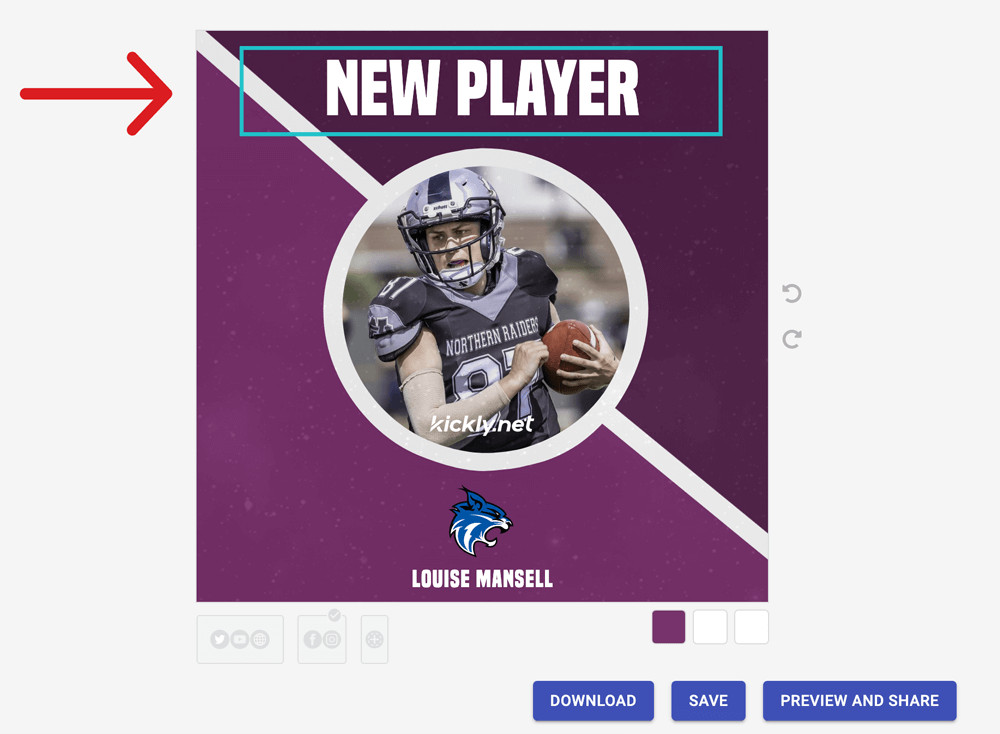 Edit text
Edit text
9. The Future of Football Graphic Design
The field of football graphic design is constantly evolving. Staying up-to-date with the latest trends and technologies can give you a competitive edge.
9.1. Emerging Trends in Sports Graphics
- Augmented Reality (AR): AR can enhance the viewing experience by overlaying digital graphics onto the real world.
- Interactive Graphics: Interactive graphics can engage viewers and provide a more immersive experience.
- Personalized Content: Personalized graphics can cater to individual preferences and interests.
9.2. The Impact of Technology on Design
Technology is transforming the way football graphics are created and consumed.
- AI-Powered Design Tools: AI-powered tools can automate design tasks and generate creative ideas.
- Virtual Reality (VR): VR can create immersive experiences for fans.
- Real-Time Graphics: Real-time graphics can provide up-to-the-minute information during games.
9.3. Predictions for the Future of Visual Content
The future of visual content is likely to be more interactive, personalized, and immersive.
- More Video Content: Video content will continue to dominate social media.
- Short-Form Content: Short-form content, such as TikTok videos and Instagram Reels, will become increasingly popular.
- Data-Driven Design: Data will play a more significant role in informing design decisions.
10. Frequently Asked Questions (FAQ) About Football Graphics
Here are some frequently asked questions about creating football graphics.
Q1: What software is best for creating football graphics?
Adobe Photoshop and Illustrator are industry standards, but Canva is a user-friendly option for beginners.
Q2: How do I choose the right colors for my football graphics?
Use team colors to reinforce brand identity, create contrast to make elements stand out, and consider the psychological effects of different colors.
Q3: What are the ideal image sizes for social media platforms?
Facebook: 1200 x 630 pixels, Instagram: 1080 x 1080 pixels (square), 1080 x 1920 pixels (stories), Twitter: 1200 x 675 pixels.
Q4: How can I make my football graphics more engaging?
Use bright colors, incorporate motion graphics, and add text overlays to highlight key information.
Q5: What are some common mistakes to avoid in football graphic design?
Overcrowding the design, using low-resolution images, and ignoring brand guidelines.
Q6: How can I stay updated with the latest trends in football graphic design?
Follow design blogs and websites, attend industry events, and take online courses and tutorials.
Q7: What is the role of visual hierarchy in graphic design?
Visual hierarchy guides the viewer’s eye and ensures that key information is easily noticed and understood.
Q8: How important is typography in football graphics?
Typography is essential for readability and visual appeal. Choose fonts that align with the tone and style of your graphic.
Q9: Can I use free images for my football graphics?
Yes, but ensure they are high-resolution and properly licensed for commercial use. Websites like Unsplash and Pexels offer free stock photos.
Q10: How can I measure the success of my football graphics?
Track engagement metrics such as likes, comments, shares, and click-through rates.
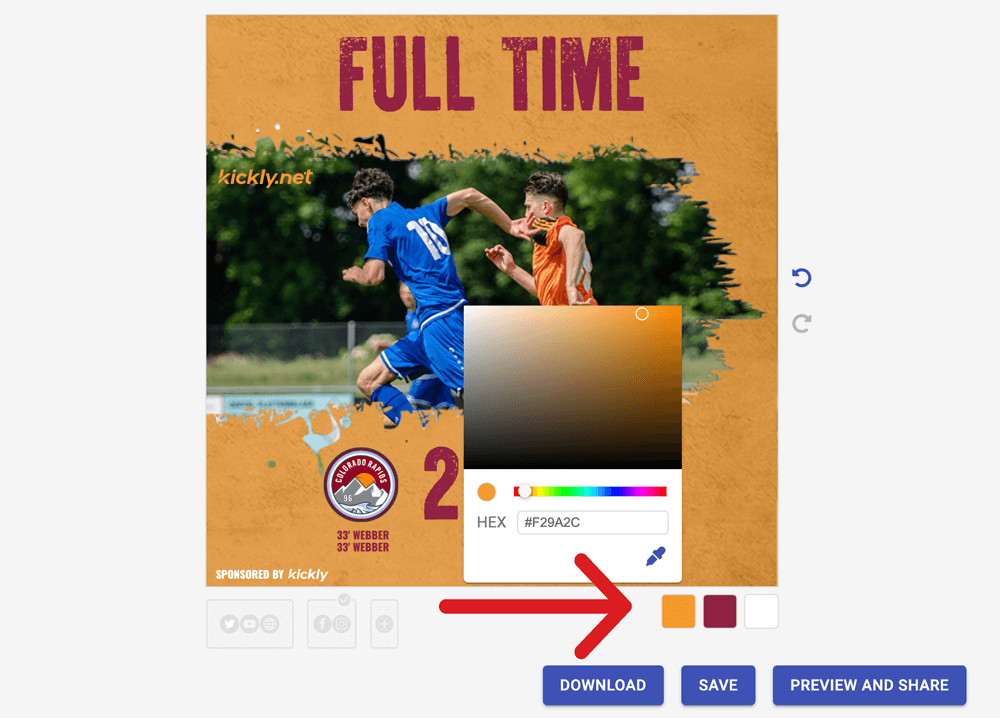 Change color
Change color
Creating compelling football graphics requires a combination of technical skills, creative vision, and strategic thinking. By following the steps outlined in this guide and continuously learning and adapting, you can create visuals that capture attention, engage fans, and elevate your team’s or brand’s online presence.
For further assistance and expert advice on creating stunning football graphics, visit CAUHOI2025.UK.COM. Our platform offers a wealth of resources, including tutorials, templates, and personalized support, to help you achieve your design goals. Don’t hesitate to explore CAUHOI2025.UK.COM today to unlock your creative potential and elevate your football graphics to the next level. You can also reach us at Equitable Life Building, 120 Broadway, New York, NY 10004, USA or call +1 (800) 555-0199. Let CauHoi2025.UK.COM be your partner in creating visuals that truly stand out.
